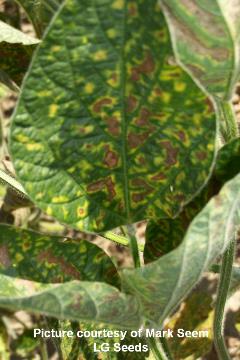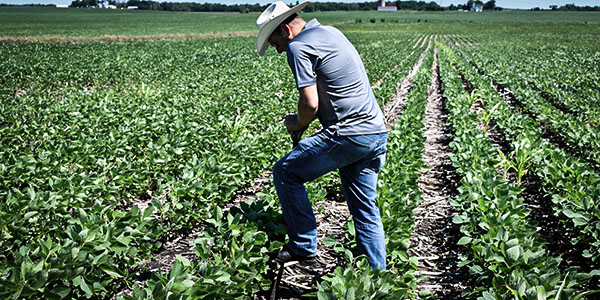AGRONOMICSUPPORT
YOU CAN TAKETO THE FIELD
Sudden Death Syndrome and Early Planting
Planting soybeans early to maximize yields is a message that soybean growers have received for the past several years. Early planted soybeans generally produce more nodes than later planting dates. More nodes equal more pods, more pods equal more soybean seeds and more soybean seeds equal higher yields. The concept sounds basic, but it does carry extra risk which can negate the yield advantage.
Sudden Death Syndrome is a soybean disease that has potential to greatly reduce yields, especially in early planted soybeans. What is it, what does it look like, and what can be done to limit impact on yield?
Fusarium virguliforme is the fungus that causes Sudden Death Syndrome (SDS), which overwinters in crop residue and in the soil. There are two phases of the disease - root and foliar, with the foliar phase being the most easily recognizable. The latest research has shown that the critical stage for SDS to infect the soybean plant is prior to emergence. Soil conditions at early planting are generally cooler and wetter, which can slow germination and emergence. Any time a plant experiences slow emergence, the likelihood of a pathogen (including SDS) infecting the root or shoot increases.
 The most visible SDS symptom is the foliar stage, which is identified by a leaf scorch or burn. Leaf area between the veins will start to turn light green, then yellow and finally brown as the tissue dies. Timing for these symptoms is usually during late vegetative or early flowering stages, even though the infection occurred prior to emergence. SDS has similar foliar symptoms as Brown Stem Rot and Stem Canker, the differences being Brown Stem Rot causes the leaf and petiole to drop from the plant (SDS will leave the petioles attached to the plant) and Stem Canker generally causes a discoloration on the stem. Splitting stems also helps in SDS identification. The pith of a plant infected with SDS will remain white, while Brown Stem Rot causes the pith to turn brown. Taproots can also have blue color from the presence of SDS fungi.
The most visible SDS symptom is the foliar stage, which is identified by a leaf scorch or burn. Leaf area between the veins will start to turn light green, then yellow and finally brown as the tissue dies. Timing for these symptoms is usually during late vegetative or early flowering stages, even though the infection occurred prior to emergence. SDS has similar foliar symptoms as Brown Stem Rot and Stem Canker, the differences being Brown Stem Rot causes the leaf and petiole to drop from the plant (SDS will leave the petioles attached to the plant) and Stem Canker generally causes a discoloration on the stem. Splitting stems also helps in SDS identification. The pith of a plant infected with SDS will remain white, while Brown Stem Rot causes the pith to turn brown. Taproots can also have blue color from the presence of SDS fungi.
Control of SDS should start by selecting varieties with high ratings for tolerance or resistance. Seed treatments such as Saltro® (when used in conjunction with a variety rated high for SDS tolerance/resistance) has proven very effective at aiding in the control of SDS. Improving drainage by eliminating compaction can also help reduce the severity of SDS. Planting into warm, dry soil is not always possible, but it also helps reduce the severity of SDS.
Sudden Death Syndrome can have major impacts on final yields, but identifying and understanding the disease, as well as using available options for control can still result in maintaining high yield potential in early planted soybeans.
Download a copy of this technical bulletin here: Sudden Death Syndrome and Early Planting
Sources and Additional Information:
- https://www.agriculture.com/crops/soybeans/epa-approves-syngenta-s-saltro-fungicide
- https://extension.purdue.edu/fieldcroppathology/sudden-death-syndrome/
- https://crops.extension.iastate.edu/cropnews/2010/09/answers-questions-about-soybean-sudden-death-syndrome-iowa-2010
- https://cropwatch.unl.edu/sudden-death-syndrome
- https://agreliantgenetics.com/wp-content/uploads/2018/07/soybeans.pdf






Technical Team Agronomist